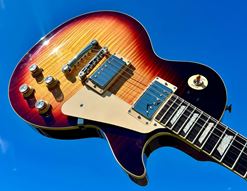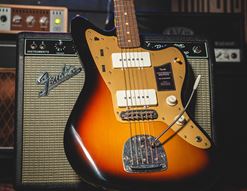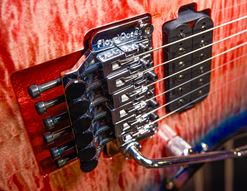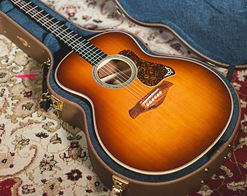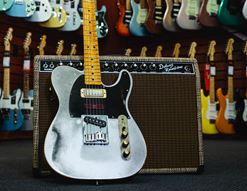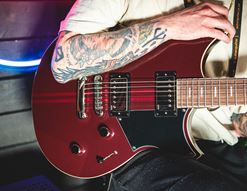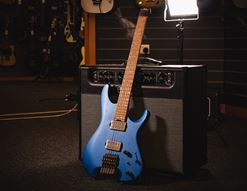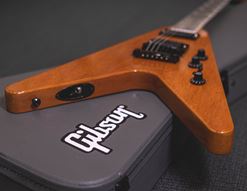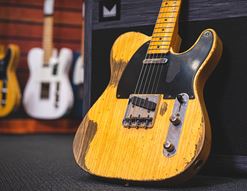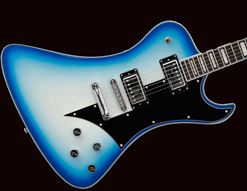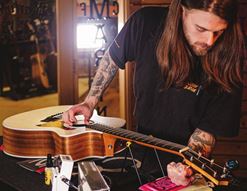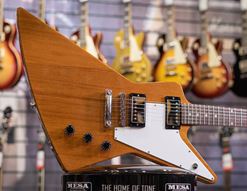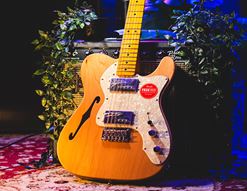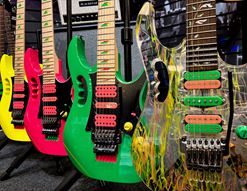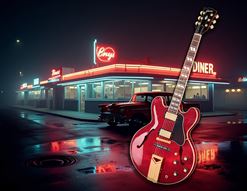I don’t know exactly when it was that I became obsessed with guitar picks, but I can’t now remember a time when I wasn’t.
Do you remember your first pick? I do. It was a Jim Dunlop RIFFS nylon pick in bright green, so it would’ve been a .96mm thickness. I got it from my brother and used it until you could slice open a tomato with the ragged edge.
At some point in the decades since, I somehow became fascinated in these little (mostly) plastic devices. I loved how much you could change the sound and feel of your performance just by altering this one little thing. It’s gotten that I need to have the ‘correct’ plectrum in my pocket (whatever ‘correct’ happens to be) or I don’t feel quite right about things.
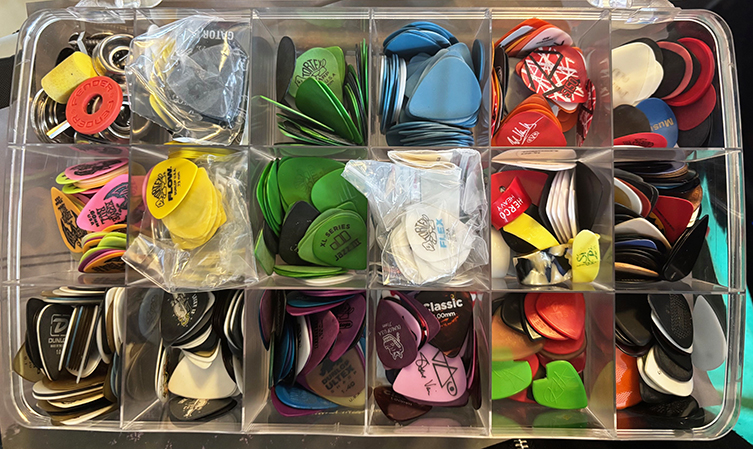
Contents
The Search for the Perfect Plectrum
Dan’s Guitar Store Precision Picks
The Search for the Perfect Plectrum
The reason I’m sharing my plectrum obsession with you today, is that I want you to benefit from my years of rigorous testing. I buy packets and packets of picks from all over the place, and hassle the purchasing staff here at guitarguitar to carry the ones that really impress me. That doesn’t mean they do it, but at least I’m not keeping my strict scientific findings to myself.
I have no real preference about material or shape when I’m off searching. If I don’t already have an example of a pick, I’ll immediately want one, and so I’ve amassed a huge stockpile of the things, which I routinely dig through, sort out and reacquaint myself with.
I have opinions on these things that I believe can be useful to you as a guitarist. If you are the type of person who settles on a particular thing like a plectrum and just sticks with it forever, then fair enough to you but I think you might be missing a few tricks! I’ll go through the main types and brands, checking out how they feel, perform and wear out, and I’ll give you my thoughts on which ones I think you should spend a few quid on to test for yourself.
Are you with me?
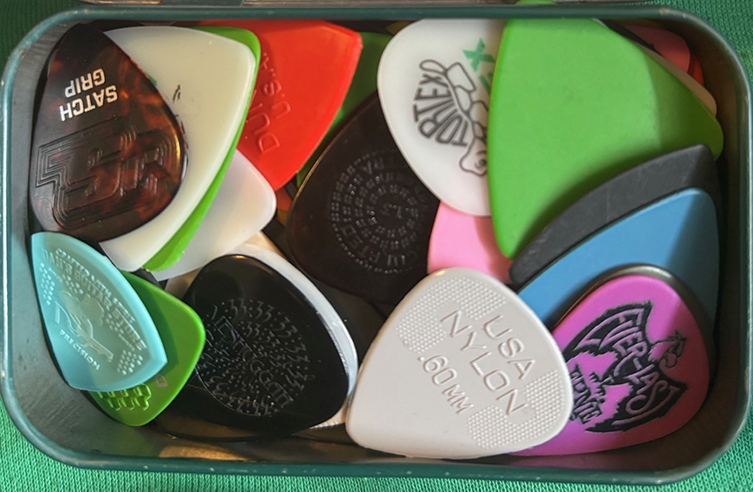
Some Brief Terms
So that we are on the same page when I try to describe plectrums, I’ve put this handy list together to help you navigate my vocabulary…
- Plectrum/pick: same thing. Entirely interchangeable term. I will use both terms.
- Flatpick: an out of date name for a plectrum/pick. Why country folk ‘flatpick’, it means they are using a plectrum. That’s it.
- Clack: ‘clack’ is the sound of the pick on the strings. Heavier picks tend to have less ‘clack’, but it can depend on the material. Some people like hearing it, and others do not.
- Flex/give: how much a pick moves when it plays a string. Stiff picks that stay rigid when strummed have little in the way of flex/give. A 0.73mm pick has a degree of flex; a 0.60mm pick of the same material has slightly more, and so on. 3mm picks have none, and feel like you’re playing guitar with someone’s tooth.
- Playing tip: the part of the pick that meets the strings. The bit you aren’t holding, basically.
- Gauge: the thickness of the pick. If it isn’t ‘Thin, Medium and Heavy’, then most picks follow the example set by Dunlop with these gauges: 0.50mm, 0.60mm, 0.73mm, 0.88mm, 1.00mm, 1.14mm. This is true of most picks, though there are always exceptions.
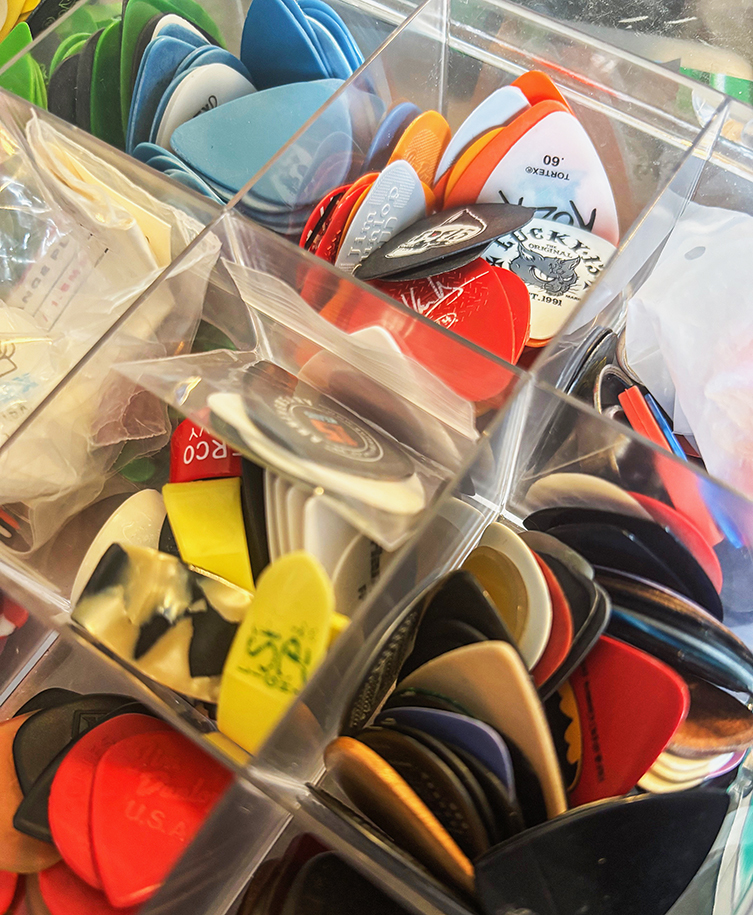
Plectrum Materials
So, as you’ll surely know, plectrums are mainly made from types of plastic. Different plastics will be more flexible or more rigid, regardless of how thick a pick actually is: a nylon 0.88mm pick is noticeably more flexible than, say, a Tortex 0.88mm, from the same manufacturer. This is worth bearing in mind when you try a new style of plectrum: just because you think you are settled in life as a ‘1mm person’ or whatever, it doesn’t mean that’ll be your best choice from a different brand or material.
So, here’s a rough breakdown on pick materials:
- Tortoiseshell: yes, literally the shell of a poor little tortoise, carved and shaped into guitar picks. Who ever had that idea? It’s highly illegal now, of course!
- Tortex: A process using a plastic called Delrin, which is given a matte, textured finish. Tortex sounds brighter than standard Delrin picks. Tortex does wear out relatively quickly.
- Delrin: A plastic used to make different kinds of picks. Relatively stiff and bright sounding.
- Ultex: Ultex is a type of polyetherimide, and sorry, I don’t know what that is. Ultex picks are very smooth, very strong, and hardwearing. They can also be pretty slippy in the hand compared to other types. Ultex has a bright sound, with locks of clacks.
- Nylon: A softer plastic with a little bit of give. Nylon glides well over strings. Thicker nylon picks still have a particular ‘soft feel’ against guitar strings. This feel will be either what you love or what you don’t love about most nylon picks. Nylon wears out relatively quickly and is a pretty silent pick in terms of clacking sounds.
- Celluloid: a classic type of pick from the 1950s. It sounds bright and sharp, and is pretty stiff. Lasts well in heavier gauges, less so in medium and light gauges. You can hear the pick clacking quite clearly.
- Acrylic: tough wearing and bright, often used for more expensive plectrums.
- Polycarbonate: used in thicker, more expensive picks, often conflated with Acrylic but in reality not the same thing. Polycarbonate is actually more durable than acrylic, but also more expensive as a material.
Okay, that’s you fully primed! It is now time for me to take you on a mind-boggling odyssey through the world of particular plectrums for practice and performance, presented with passion and precision!
Dunlop Tortex
I’ll begin with the world famous Dunlop Tortex picks. These are by far the best-selling and most-used plectrums on the market. Tortex itself is designed to behave and feel like actual tortoiseshell, which as we know is what primitive guitar picks were made from back in the day. That practice was thankfully outlawed many decades ago, but players did enjoy the feel of the material.
Now you know the origin of the word ‘Tortex’ and the reason for the tortoise logo!
Tortex, then, is a plastic called Delrin, which is treated to a physical ‘tumbling’ process that gives each pick its signature texture.
Tortex Colour and Gauge
Tortex picks have done much to define the plectrum world. Their colour-coded thicknesses can be seen in variants across the market: it’s a bit like identifying the crisps you like in the supermarket directly by the packaging colour. Each thickness has its own corresponding colour. It’s now at a point where we talk about how we prefer ‘Tortex yellow’ or ‘Tortex orange’, without referring to the actual gauge, because most guitarists instantly know what the colours all refer to.
Here’s the colour code, and the thicknesses available:
- Tortex red: 0.50mm - really thin!
- Tortex Orange: 0.60mm
- Tortex Yellow: 0.73mm
- Tortex Green: 0.88mm
- Tortex Blue: 1.00mm
- Tortex Purple: 1.14mm
- Tortex White (only certain pick shapes): 1.5mm
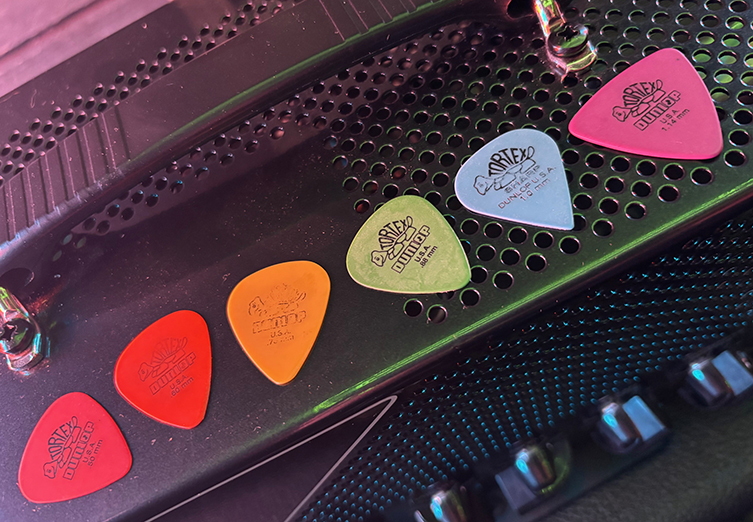
Picks do come much heavier than this - from Dunlop and from other manufacturers - but Tortex don’t tend to. These gauges have spread out into the guitar universe as the leading standard. Most guitar players will have a preference of gauge based either on Tortex or Dunlop’s Nylon range, which will appear in this blog soon enough.
Tortex Shape
Now, shape is the other big concern there. For the purposes of this blog, I’m going to refer to the standard, vaguely teardrop shaped picks as ‘regular’. Fender name the shape as the ‘351’ but it’s so ubiquitous that I’m fine with ‘regular’. It’s the normal plectrum shape that you’ve all got at home right now.
So, Tortex picks are available in a large number of shapes. I think I’ve captured them all here, but new ones are added frequently!
- Regular - not too big, not too small, not to sharp, not too blunt.
- Triangle - larger size, with three playable tips that are slightly wider/blunter than regular picks. These are not just for bassists! The wider tip means more contact with the string. I personally like that, but not everybody wants that.
- Flow - sharp and somehow wide at the same time. Relatively new, very popular.
- Jazz III - smaller and sharper than a regular pick. It’s a whole chapter on its own (see below)
- Jazz III XL - as above but approaching regular size.
- Tortex III - tip of a Jazz III, otherwise normal; precursor to the Flow shape.
- Tortex Sharp - very thin tip for extremely precise picking. Not a delight to strum with.
- Fin - shaped like a surreal fishes fin, with several playable tips that are all different.
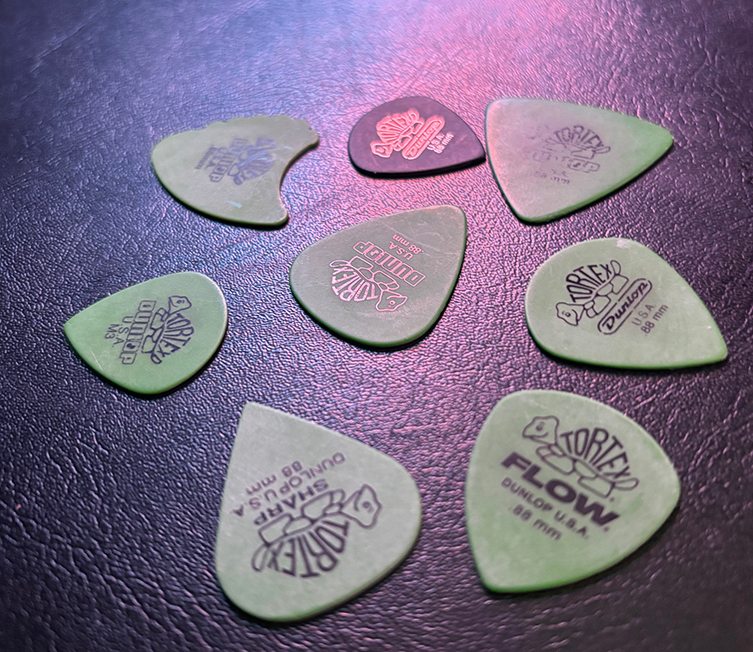
Which Tortex?
Which Tortex should you go for? Well, here's my thoughts, filtered through endless hours of swapping picks in and out of my hand, testing the feel, resonance and my performance with them. These bullet points will explain…
- The regular shape is most popular for a very good reason.
- I love the big triangles and find them to be a bit of a secret weapon, but perhaps not for shredding.
- The Fin shape gives some genuinely interesting sounds (particularly the ‘bumpy’ bit), but the shape also gets in my way when I play.
- There is almost no appreciable difference between the Jazz III XL size and the Tortex III. Both are great.
- The Tortex Sharp is amazingly effective at precision playing, but wow, I just do not like using them.
- The Flow took some getting used to (I felt like they were weirdly short and I missed strings occasionally, which sounds mad but is completely true) but I’ve since really come round to them. Not a favourite, but I can see why they are for many others.
In the end, my top Tortex shapes are the regular one and the triangle, with the Flow just behind them. I love the Jazz III XL shape, but actually prefer it as a ‘proper’ Jazz III XL, which I talk about below.
And Gauge? Well, I habitually go back and forth between Tortex yellow, green and blue. Of these three, the blue is third for me, primarily because I find that a little bit of give is useful for rhythmic playing. The truth is that your hands get used to whatever you are using, and so all are good, but if you want my take on it, a regular Tortex green is damn hard to beat!
Tortex Flex
Tortex Flex is a more recent take on the Tortex formula. As the name suggests, these are a slightly less rigid take on the classic, with a feel that, to me at least, is drifting in the direction of nylon picks. That slightly softer connection to the string is specifically different to regular Tortex, and each gauge does feel significantly more ‘wiggly’ than its regular Tortex counterpart. I’d recommend going up one gauge from your normal preference with these: so if you are a 0.60mm person, try going for a 0.73mm.
Tortex Flex X is an even newer innovation. Dunlop have taken the Flex picks and stamped out an ‘X’ shaped hole in the middle. This is to aid grip, and I’m finding that I really like them! I’ve yet to settle on a specific gauge, but the 1.00mm one - Tortex Blue in pick parlance - is ticking lots of boxes for me right now!
Ernie Ball Everlast Picks
I first saw these Ernie Ball Everlast picks during endless online trawls online a few years back. I will readily admit that I’m not above being attracted to pretty colours, so I tried a pack of the orange 0.73mm ones before deciding to also grab the lovely neon yellow ones (0.88mm), the purple ones (1.00mm) and the wild pink ones (0.60mm). They make for quite a set!
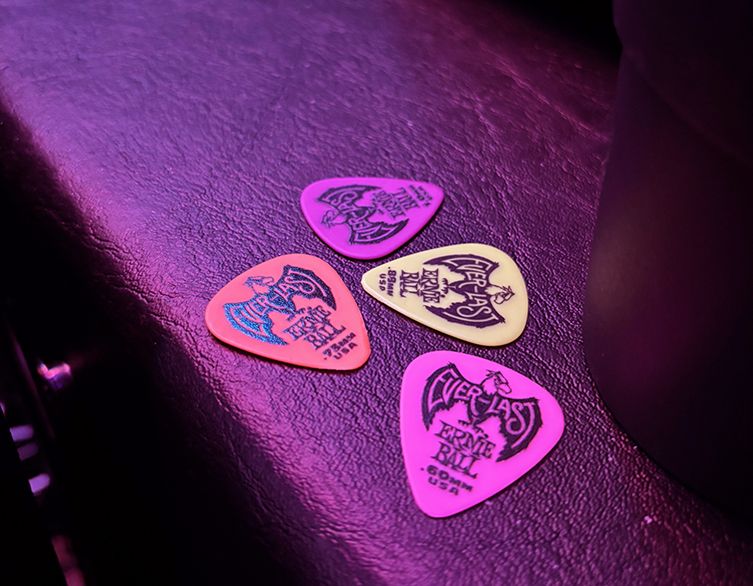
Now, nobody has ever said I’m not a facetious man, but these picks will eventually wear out, okay? It’ll take yonks, but it will happen! Everlast? Not quite. They are very hard-wearing though. Ernie Ball Everlast picks are made from Delrin, just as Tortex picks are, and it seems to me that these are definitely EB’s answer to Tortex. I would say that have more life in them though.
So, how did I find them in use? It’s interesting, because although the gauges are numerically the same as Tortex picks, these feel heavier/stiffer to me. This has brought some interesting results:
- The Everlast 0.73mm is a very useful pick for almost everything
- The Everlast 0.60mm has that tiny bit ‘more’ than the Tortex, making it a better choice for my needs. (The orange Tortex is a little too flexy for me, mostly).
- The Everlast 0.88mm feels a little bit too chubby compared with the almighty Tortex green, and I find myself vastly preferring the feel of the Tortex.
D’Addario Duragrip
I tried these out because I liked the idea of a ‘Tortex-style’ pic with a textured surface. These are good pics but had that same Everlast thing of being a little chunkier and stiffer than I maybe expected in my chosen gauge of 0.88mm. These are made from Delrin (well, ‘Duralin’) and appear to be pretty hard-wearing, but they haven’t quite made it into my personal top ten. That’s just me though: you give them a go if they appeal to you. Anthrax’s Scott Ian uses them, and I’m not about to argue with that guy.
Dunlop Jazz III
Small, thick and bright red, the Dunlop Jazz III is one of the most well-loved picks ever. It comes in a variety of sizes and styles these days, with the XL one still being slightly smaller than a regular pick.
Why do people love it so much? Well, I have a theory about that. I think Jazz III picks encourage you to be more present with your playing, and they encourage a tactile approach. Why? I think their small size makes people feel like they are detailing their playing with a fine paintbrush, as opposed to a big thick square brush that doesn’t allow for any subtlety. The small sizes promotes movement from the finger digits themselves, as opposed to the full finger, or indeed wrist.
Maybe I’m getting carried away.
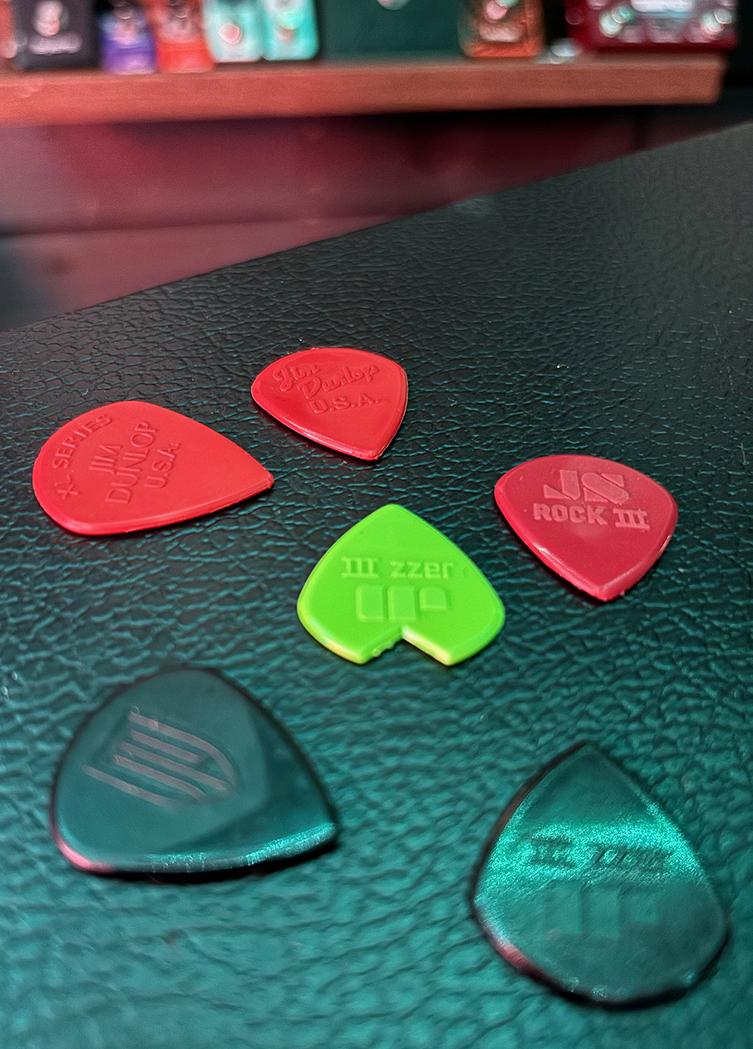
Jazz I and II picks exist too (they are just more blunt looking), but the III is king. Most are made with nylon and are red, but you can get black versions, and Ultex ones in a see-through amber shade than isn’t better. Kirk Hammett and Andy Timmons have signature Jazz III picks, too. I’d note here that loads of Dunlop picks now offer the Jazz III shape (particularly the XL shape), but that doesn’t make them Jazz III picks to me. Does that make sense? A Tortex 0.73mm in a Jazz III shape is still a Tortex pick to me.
So what Jazz III variants are out there? Here are the ones I checked out…
- Regular red Jazz III: really good, but too small for me overall. I mean, sometimes it’s absolutely perfect, but not on a consistent basis.
- Rock III: a very slightly different shape here, and equally as nice as the Jazz III. I’ll be honest: there’s not enough actual difference here for me to have a preference. It’s a slightly less nice shade of red, too!
- Jazz III XL: the usual red nylon Jazz III but larger. MUCH BETTER! I love this pick.
- Jazz III XL Ultex: As above, but harder-wearing with more of a ‘glide’ over the strings thanks to that smoothness. Very good indeed, but I actually prefer the slightly more tactile feel (and more quickly worn down material) of the red nylon Jazz III XL.
- Tortex Jazz III (yellow and green were what I tried): these are Tortex pics to me, so they don’t give a Jazz III experience at all! They are great pics, but great for their Tortex vibes.
- Jazz III Kirk Hammett: small-sized Jazz III in neon green (ace!) with a chunk removed from the top for extra grip. If you like normal (small) Jazz III picks, I reckon you’ll dig these. They are usually too small for me, so I really want Dunlop to do an XL version!
- Jazz III John Petrucci: a particularly different vibe here, with a smooth tip and textured grip. It glides with precision (as you’d expect) but it’s still a bit much for a gig’s worth of strumming in my opinion. For shredding though? Immense.
Jazz III picks are great for precise playing. Lead guitar parts, tricky riffing and generally more technical stuff is all made easier in my opinion with one of these. Where the Jazz III is perhaps less usual - from my perspective - is in rhythm playing. I don’t think they are fantastic to strum with, where their lack of ‘yield’ or ‘give’ stunts the right hand’s flow of rhythmic expression a little. Does that make sense? For everything else though, they are about as good as it gets.
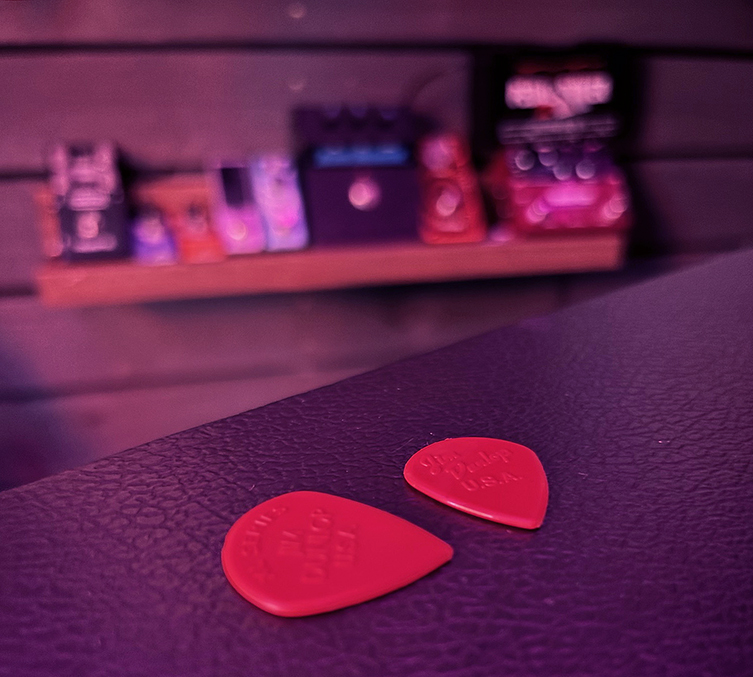
Celluloid Picks
Celluloid is an old-school type of pick. When you see Fender Medium, D’Addario Heavy and so on, you’re often seeing celluloid picks. Those ones that look like Tutti-Frutti? Celluloid. The ones that look like they’ve been made out of Tortoiseshell-coloured pickguards? Celluloid.
Celluloid has a bright, clear sound and is smooth to the touch. Sweaty players may find that celluloid slips out of their fingers in the heat of battle, but there are some varieties with textured grips, too. One that I found recently - and loved - is the D’Addario Satch Grip.
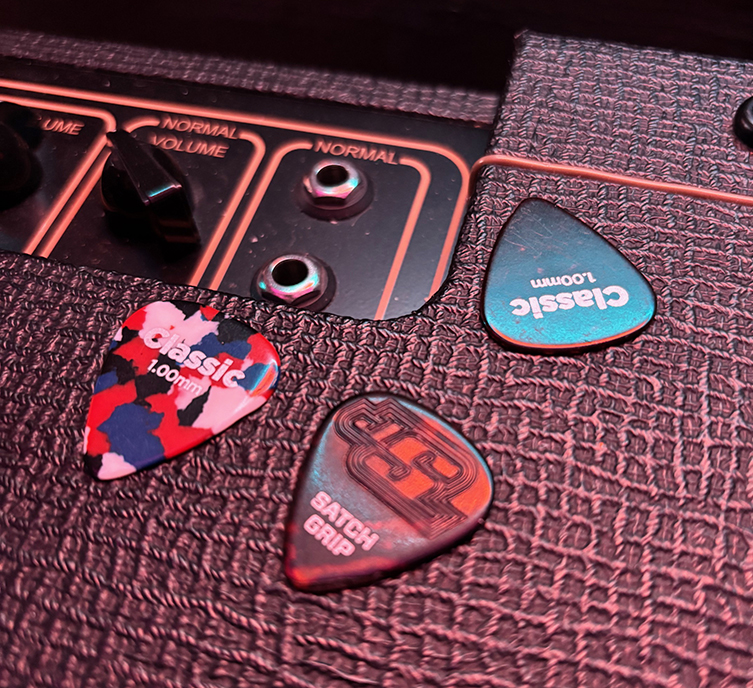
Now, (name drop) I’ve actually had a good few chats with Joe Satriani about guitar picks, and so I know that he changes up his plectrums pretty often depending on what he’s doing. However, this Satch Grip pick is his general use go-to, and I have to say that it’s up there with the best. It’s 1.25mm celluloid, so pretty heavy, and it has a textured logo grip to stop it flying out of your hand. Best all - and true of all celluloid plectrums - is how easy the tip glides over the strings. It’s very smooth and fast, allowing you to have adventures with your playing.
Celluloid can wear out pretty quickly, so thinner gauges will need replacing relatively often. The heavier ones of course - like this Satch Grip - will go a lot longer, and accrue a finer tip over the weeks and months. I recommend trying these!
Celluloid wears in a kind of rough way, which I happen to think sounds really cool. I notice this most on the 'heavy' picks, which equate to roughly 1mm. Thinner celluloid picks maybe don’t have the edge surface to hold the wear in the same way. As with all picks, thinner ones sound more trebly, and have a longer ‘recovery’ time.
Nylon Picks
A huge amount of guitar picks are made from nylon. We’ve seen the Dunlop Jazz III range, which is mainly nylon. I’ll talk about Herco picks in a second, which are another classic nylon plectrum. But there’s loads out there!
Most companies have their version of nylon picks, and they do mostly conform to Dunlop’s standardised gauges, with additional super-skinny picks existing with gauges of 0.46mm and even 0.38mm!! Now, I’ll be straight with you and tell you that I have absolutely no use for such thin picks. It’s just my take, but then this blog is a personal journey after all! I have never been able to find a good use for these skinny things: anything below a 0.60mm feels a bit futile to me, like strumming with a sheet of paper. Not enough control! But if you love them, that’s totally valid. I might not come and see your band, though, but you do you.
Anyway, I’ve been through a bunch of nylon picks, so here’s a brief tally on how they performed for me:
- Dunlop Nylon Standard: There’s a tactile softness to these that some players love, and I appreciate up to a point. I don’t always get the precision I need from these, compared with other types. For strummy players, though, these are popular.
- Dunlop Nylon Max Grip: A big improvement over the standard ones, for me. The Max Grip is excellent, it really works well! Still quite soft picks. I tried the EVH signature ones out of curiosity, and I cannot believe that Eddie played as he did with a nylon 0.60mm pick!
- Dunlop Meshuggah Signature Pick: this one is great, actually! It’s 0.96mm with a grip and it’s made from a mixture of nylon that makes them a tiny bit stiffer than standard ones. Do I believe that? Well, kind of, because it does give me a little more strength and ‘return’ when I’m playing 16th notes at 140bpm. Well worth checking out.
Herco Picks
I bet you‘ve heard of these because of David Gilmour and Jimmy Page, right? Herco picks are quite flexible nylon picks with a textured grip. There’s two main gauges available: a silver one called Herco Flex 75 and a gold one called Herco Flex 50.
Common sense would dictate that those numerics would indicate thickness, right? That the silver would be a 0.75mm thickness? Nope. I don’t know why those numbers are on there, because the silver one is 1.01mm. The gold one? 0.65mm. Go figure!
They certainly have movement in them, and are quite comparable in my opinion to the Nylon Max Grip picks. Try them for yourself, but I still think there’s too much flexibility here for a pick that’s 1mm. Well, 1.01mm. So what if Gilmour likes them? These are not for me.
Dan’s Guitar Store Precision Picks
I admit that I was suckered in by the marketing and cool ‘peppermint’ colour of the original Dan’s Precision Pick. I bought a pack and, though initially critical of the mould lines that I found on mine (a byproduct of the injection mould process, just like you’d get with, say, a Warhammer miniature), these were easy enough to clean up with a craft knife.
What remained is easily one of the best plectrums I’ve used in a long time. The Precision pick is ace: it’s like a slightly stiffer Jazz III XL, with less weight and a touch of additional brightness. I found myself reaching for one more and more often, and also passing them on to my guitar playing friends to try.
These are some serious competition for the Jazz III! The company now offer more varieties, and I admit I have not ventured further, personally, but I’m sure I will.
Acoustik Attak - Attak Piks
I first heard about Acoustik Attak picks (piks?) when I was chatting to (another name drop) Devin Townsend. He revealed off-record that he’d been working with the brand to develop something entirely new. I was excited! Knowing him to favour the triangle shaped Tortex 0.88mm picks, I did wonder what would eventually show up.
Long story short, I bought Devin’s Earthtone picks (1mm triangles with one tip being serrated for a particular tone) and, liking them (but wishing they were less rigid), ordered a variety pack of Acoustik Attak’s other styles. They have a bunch, and they are perhaps the most unique of any brand I’ve tried. There is no real gauge or thickness to compare against here: they all have their own size, texture and 3-dimensionality, and their shapes defy the normal comparative process.
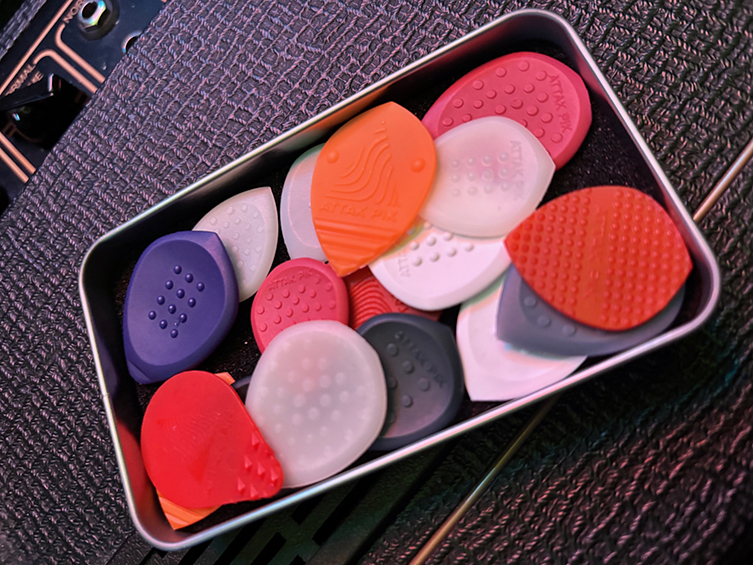
If you were aboard the Starship Enterprise, and found that Captain Picard was fond of a wee shred now and then, these are the picks you’d see scattered absent-mindedly around his Captain’s chair in the bridge.
It’s very refreshing to see genuinely new ideas in plectrum design. Acoustik Attak are offering up a look, feel, performance and sound that is a true alternative. For those reasons alone, I feel that they are worth your time exploring. The package I bought contained a great many of their styles, including their Stealth, Fusion, Viper and many other types.
Now, the burning question is: are they any good? Yeah, they’re definitely good picks, but approach them on their own terms instead of seeing if you prefer them to your favourite celluloid Mediums or whatever. I see these as being ‘as well as’ picks for certain situations, rather than a replacement for anything. Some of these Attak Piks have special textured tips for different sounds, and they certainly deliver those!
So, no one Attak Pik is a ‘must-have’ essential, but a selection of them will brighten up your playing and prove very useful. Plus, it’s a completely different feel in your hand, and that in itself will change up your playing style. Investigate, if you are intrigued!
My Favourite Picks
You know, I could keep going here, but we all have homes to go to, and I understand that there’s only so much that you need to hear about guitar picks. You’ve come this far, so let me round things up with my favourite choices. I’ll briefly tell you why I like these so much, and then you can decide how much they might be useful to yourself.
- Dunlop Jazz III XL Nylon: the big red boy is a very tough choice to beat for all lead and melodic styles. It’s reliable and it feels great. As mentioned, I don’t love it for strumming, but for everything else, it’s an excellent choice.
- Ernie Ball Everlast 0.60mm: awesome pink colour, nice bit of grip thanks to the printed logo, and a slightly stiffer-than-Tortex material give this pick the edge over its more famous orange competitor. I’m not normally a 0.60mm fan, but this is a great exception.
- Dunlop Meshuggah Signature: the best non-Jazz III nylon pick in my opinion. You get the nylon feel, and it has a little bit of give (not much!), along with a level of control that feels great.
- Dan’s Guitar Store Precision Pick: an excellent all-rounder that feels very nice in the hand and allows lots of dynamics. Still not incredible for chords, but in most ways this is a real competitor for the Jazz III XL, whilst offering a different connection to the string and overall feel.
- D’Addario Satch Grip: even if you don’t think you want to know about a 1.25mm celluloid pick with a grip, I have a feeling you won’t put this down once you have it in your hand. You can really get stuck in with this one. Clear and detailed sound without being ‘pingy’.
- Dunlop Tortex, 3 styles: in the end, Tortex is still the king of the picks as far as I’m concerned! They wear out a little quickly for my liking, but then they are not exactly expensive to replace. You go with your preference for shape and gauge, but here are the three that I need, at all times:
- 0.73mm Tortex Yellow Triangle: I can play absolutely anything with these, with the added bonus that all three tips are playable edges. This is the ultimate triangle pick, and I’ve tried them all!
- 0.88mm Tortex regular: If I’m heading out for a gig and I only have one pick (which I understand is silly), then I’m taking this one. The regular shape Tortex in 0.88mm is such a good conglomeration of size, edge, texture, response and tone. Tortexes get warmer the thicker they get, and this one is bang on the money.
- 1.00mm Tortex Flex X: I often like a Tortex Blue anyway, but this one is more like half blue and half green thanks to the Flex difference. Also, that X centre hole is an excellent idea that I want to see more of!
Try Some New Plectrums
Those were my findings, folks. I had to tie it up a bit because this blog is growing quite ‘epic’, so you won’t hear me talking about Primetone, Gator Grip, Ibanez Delrin and D’Addario Cortex picks. If you want to hear more about all of these, gimme a holler and I might expand this piece somewhere down the line.
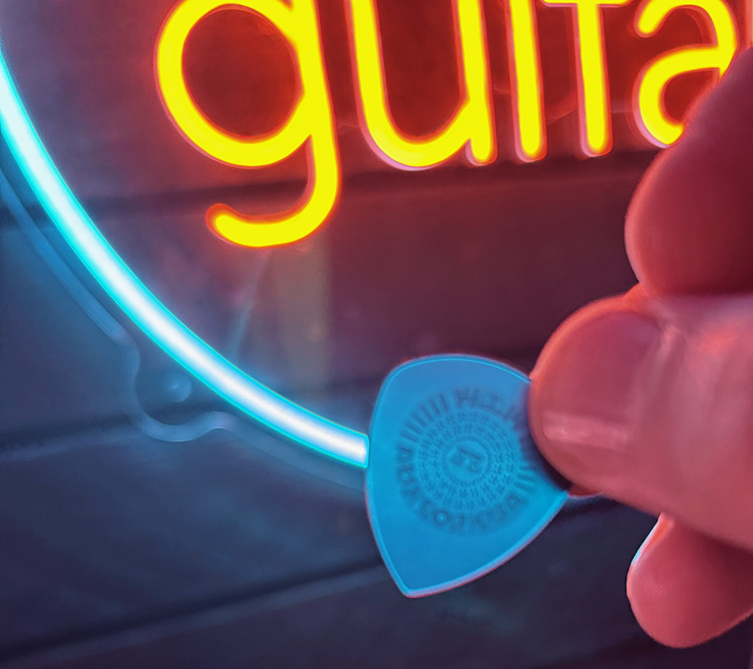
Inevitably, there’s a lot of Dunlop picks here. That’s not by design, nor was this blog in any way endorsed or set up by them. Dunlop just massively dominate the market for picks, and they also look after heritage pick brands such as Herco, so there was always going to be lots of their stuff in this blog. I reached out to some other pick companies who didn’t rise to my challenge of sending over picks to try, so they will remain nameless in their shame.
What I really want is for you to open your mind to the world of plectrums. I want you to realise that there maybe isn’t one plectrum for absolutely every musical circumstance. In fact, there are so many damn picks out there, that there is almost certainly a perfect pick for every occasion, and you might end up like me, with a ‘top 5’ picks instead of just one.
Yes, there were 6 pick choices in my top 5. You noticed! Good for you. I suppose there were actually 8, if you factor in the three Tortex choices. It’s clear that I can’t settle on a ‘best’ pic, and that’s why I keep buying the things. The larger point here is that I reckon your playing will benefit if you do the same. Keep trying new picks just like you’d try new guitars and pedals, because everything matters, no matter how large or small.
None of these are expensive, so if you’re intrigued by today’s findings, treat yourself to a few bags of plectrums. Choose some that are nothing like what you normally use, and stick with them for a good couple of hours. Re-energise your playing for very little cost. See what happens!
Click to View our Selection of Plectrums


